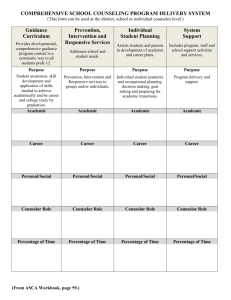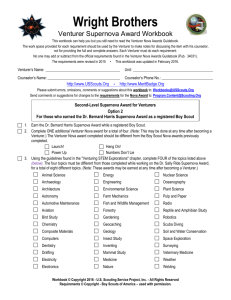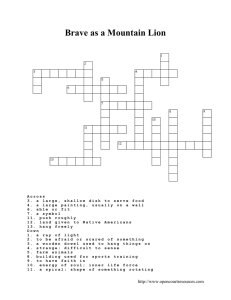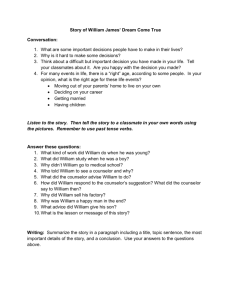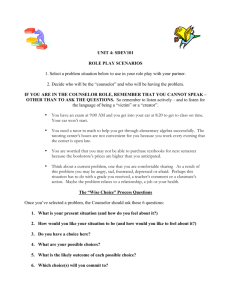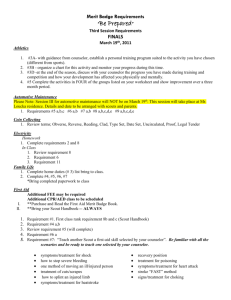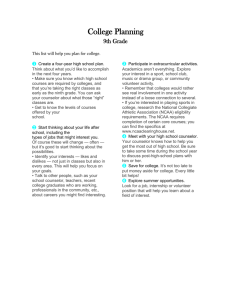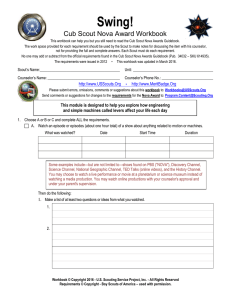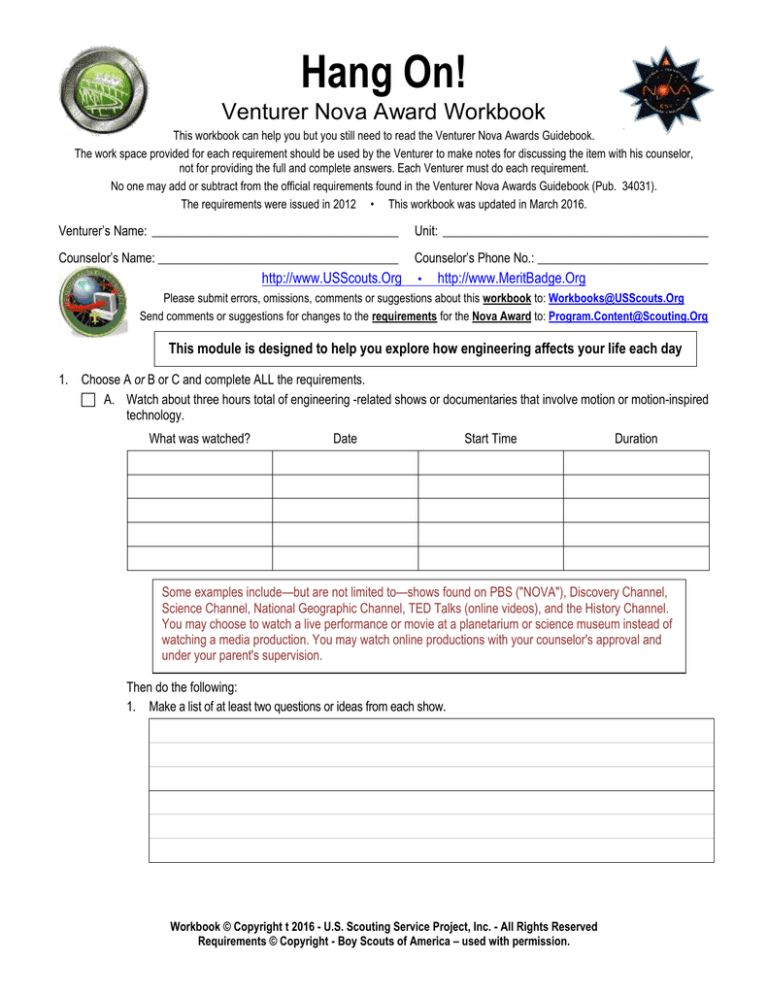
Hang On!
Venturer Nova Award Workbook
This workbook can help you but you still need to read the Venturer Nova Awards Guidebook.
The work space provided for each requirement should be used by the Venturer to make notes for discussing the item with his counselor,
not for providing the full and complete answers. Each Venturer must do each requirement.
No one may add or subtract from the official requirements found in the Venturer Nova Awards Guidebook (Pub. 34031).
The requirements were issued in 2012 • This workbook was updated in March 2016.
Venturer’s Name: _______________________________________
Unit: __________________________________________
Counselor’s Name: ______________________________________
Counselor’s Phone No.: ___________________________
http://www.USScouts.Org
•
http://www.MeritBadge.Org
Please submit errors, omissions, comments or suggestions about this workbook to: Workbooks@USScouts.Org
Send comments or suggestions for changes to the requirements for the Nova Award to: Program.Content@Scouting.Org
This module is designed to help you explore how engineering affects your life each day
1. Choose A or B or C and complete ALL the requirements.
A. Watch about three hours total of engineering -related shows or documentaries that involve motion or motion-inspired
technology.
What was watched?
Date
Start Time
Duration
Some examples include—but are not limited to—shows found on PBS ("NOVA"), Discovery Channel,
Science Channel, National Geographic Channel, TED Talks (online videos), and the History Channel.
You may choose to watch a live performance or movie at a planetarium or science museum instead of
watching a media production. You may watch online productions with your counselor's approval and
under your parent's supervision.
Then do the following:
1. Make a list of at least two questions or ideas from each show.
Workbook © Copyright t 2016 - U.S. Scouting Service Project, Inc. - All Rights Reserved
Requirements © Copyright - Boy Scouts of America – used with permission.
Hang On!
Venturer’s Name: ________________________
2. Discuss two of the questions or ideas with your counselor.
1.
2.
B. Read (about three hours total) about motion or motion-inspired technology.
What was read?
Date
Start Time
Duration
Examples of magazines include—but are not limited to—Odyssey, Popular Mechanics, Popular
Science, Science Illustrated, Discover, Air & Space, Popular Astronomy, Astronomy, Science News,
Sky & Telescope, Natural History, Robot, Servo, Nuts and Volts, and Scientific American.
Hang On! – Nova Award Workbook
Page 2 of 10
Hang On!
Venturer’s Name: ________________________
Then do the following:
1. Make a list of at least two questions or ideas from each article.
2. Discuss two of the questions or ideas with your counselor.
1.
2.
Hang On! – Nova Award Workbook
Page 3 of 10
Hang On!
C
Venturer’s Name: ________________________
Do a combination of reading and watching (about three hours total).
What was watched or read?
Date
Start Time
Duration
Then do the following:
1. Make a list of at least two questions or ideas from each article or show.
2. Discuss two of the questions or ideas with your counselor.
1.
Hang On! – Nova Award Workbook
Page 4 of 10
Hang On!
Venturer’s Name: ________________________
2.
2. Choose ONE STEM field of interest from the following list. Complete ALL the requirements for a Venturing STEM exploration
in that field. (If you have already completed a Venturing STEM exploration in one of these fields, please choose a different field
for this award.)
Archery
Electronics
Railroading
Aviation
Engineering
Rifle Shooting
Composite Materials
Inventing
Robotics
Drafting
Model Design and Building
Shotgun Shooting
Composites can be found just about everywhere: in airplanes and sports cars, golf clubs and guitars, boats and baseball
bats, bathtubs and circuit boards, and even bridges. Composites make bicycles and skis lighter, kayaks and fishing poles
stronger, houses warmer, and helmets tougher." Choose one of these items for your discussion to answer requirement 3c.
3. Do ALL of the following:
A. Make a list or drawing of the six simple machines.
Hang On! – Nova Award Workbook
Page 5 of 10
Hang On!
Venturer’s Name: ________________________
B. Be able to tell your counselor the name of each machine and how each machine works.
Helpful Links
"Six Simple Machines": ConstructionKnowledge.net Website:
:http://www.constructionknowledge.net/general_technical_knowledge/general_tech_basic_six_simple_machines.php
Hang On! – Nova Award Workbook
Page 6 of 10
Hang On!
Venturer’s Name: ________________________
C. Discuss the following with your counselor.
1. The simple machines that were involved with the motion in your chosen STEM exploration (Hint: Look at
the moving parts of an engine to find simple machines.)
2. The energy source causing the motion for the subject of your STEM exploration
3. What you learned about motion from doing the STEM exploration
4. Choose A or B and complete ALL the requirements.
A. Visit an amusement park.
Location visited:
Then discuss the following with your counselor:
1. The simple machines present in at least two of the rides
1.
2.
Hang On! – Nova Award Workbook
Page 7 of 10
Hang On!
Venturer’s Name: ________________________
2. The forces involved in the motion of any two rides.
1.
2.
B. Visit a playground.
Then discuss the following with your counselor:
1. The simple machines present in the playground equipment
2. The forces involved in the motion of any two playground fixtures.
1.
2.
5.
Do the following:
A. On your own, design one of the following and include a drawing or sketch: an amusement park ride OR a
playground fixture OR a method of transportation
Amusement Park Ride
Playground Fixture
Method Of Transportation
Hang On! – Nova Award Workbook
Page 8 of 10
Hang On!
Venturer’s Name: ________________________
B. Discuss with your counselor:
1. The simple machines present in your design
2. The energy source powering the motion of your creation
6. Discuss with your counselor how engineering affects your everyday life.
Hang On! – Nova Award Workbook
Page 9 of 10
Attachment – (NOTE: It is not necessary to print this page.)
Important excerpts from the ‘Guide To Advancement’, No. 33088:
The ‘Guide to Advancement’ (which replaced the publication ‘Advancement Committee Policies and Procedures’) is the official
Boy Scouts of America source on advancement policies and procedures.
[ Inside front cover, and 5.0.1.4 ] — Unauthorized Changes to Advancement Program
No council, committee, district, unit, or individual has the authority to add to, or subtract from, advancement
requirements. (There are limited exceptions relating only to youth members with disabilities. For details see section 10,
“Advancement for Members With Special Needs”.)
[ Inside front cover, and 7.0.1.1 ] — The ‘Guide to Safe Scouting’ Applies
Policies and procedures outlined in the ‘Guide to Safe Scouting’, No. 34416, apply to all BSA activities, including those
related to advancement and Eagle Scout service projects. [Note: Always reference the online version, which is updated
quarterly.]
[ 7.0.3.1 ] — The Buddy System and Certifying Completion
Youth members must not meet one-on-one with adults. Sessions with counselors must take place where others can view
the interaction, or the Scout must have a buddy: a friend, parent, guardian, brother, sister, or other relative —or better
yet, another Scout working on the same badge— along with him attending the session. When the Scout meets with the
counselor, he should bring any required projects. If these cannot be transported, he should present evidence, such as
photographs or adult certification. His unit leader, for example, might state that a satisfactory bridge or tower has been
built for the Pioneering merit badge, or that meals were prepared for Cooking. If there are questions that requirements
were met, a counselor may confirm with adults involved. Once satisfied, the counselor signs the blue card using the date
upon which the Scout completed the requirements, or in the case of partials, initials the individual requirements passed.
[ 7.0.3.2 ] — Group Instruction
It is acceptable—and sometimes desirable—for merit badges to be taught in group settings. This often occurs at camp
and merit badge midways or similar events. Interactive group discussions can support learning. The method can also be
attractive to “guest experts” assisting registered and approved counselors. Slide shows, skits, demonstrations, panels,
and various other techniques can also be employed, but as any teacher can attest, not everyone will learn all the
material.
There must be attention to each individual’s projects and his fulfillment of all requirements. We must know that every
Scout —actually and personally— completed them. If, for example, a requirement uses words like “show,” “demonstrate,”
or “discuss,” then every Scout must do that. It is unacceptable to award badges on the basis of sitting in classrooms
watching demonstrations, or remaining silent during discussions. Because of the importance of individual attention in the
merit badge plan, group instruction should be limited to those scenarios where the benefits are compelling.
Page 10 of 10

